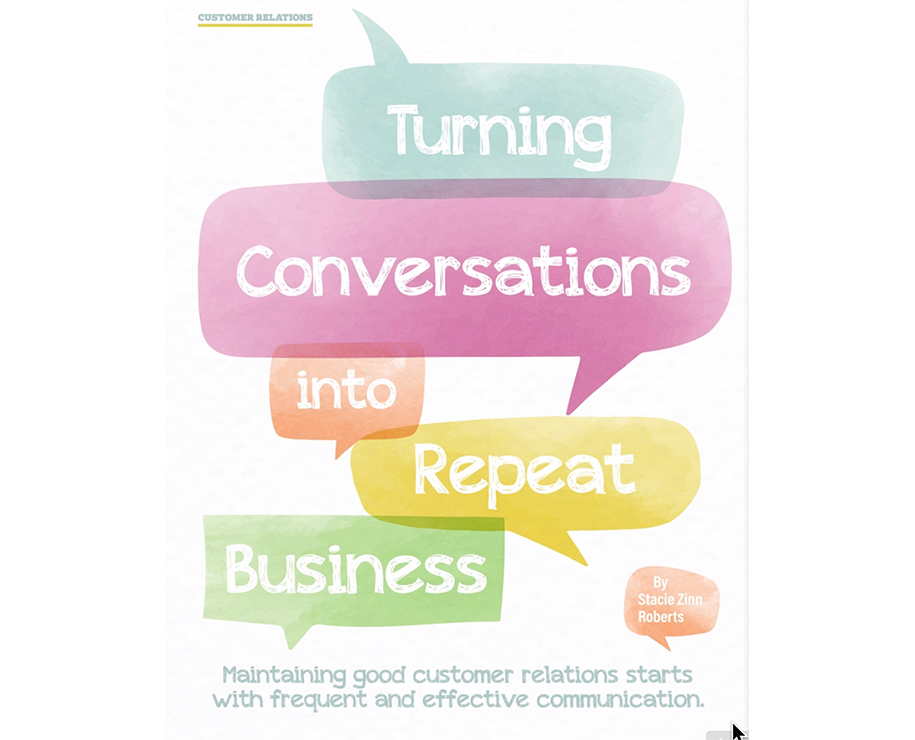Maintaining good customer relations starts with frequent and effective communication.
Jason Kopke, owner of Arizona Landshapes in Tucson, recalls an incident eight years ago, when he neglected a referral source that had kept one of his two-person crews busy six days a week. That source decided to pull its business from the company. Ouch.
At about the same time, a few customer service snafus led to some not-so-nice Yelp reviews. Double ouch. As painful as both these experiences were, Kopke says they pushed him to institute stronger customer service initiatives that made him a better business owner and benefited his customers in the long run.
“All of that work went away, and it was a big, big kick in the tail end that we needed to change something,” says Kopke. “So right there, we made a decision that we needed to address people’s concerns differently.”
Arizona Landshapes used to lose clients “all the time” because Kopke’s crews did something a client didn’t want done or failed to do something a client did want. But that is all in the past now. Today, Kopke says, “We spend more time reaching out to customers before we do any sort of service, even the monthly ones. We’ll email them at the beginning of the month to tell them when we’ll be there and ask for their input about things on their property that need to be taken care of.”
Kopke learned the hard way that maintaining customer relationships is critical to long-term success. Research shows that it costs five times more to attract a new customer than to keep an existing one. Not only that, a mere 5% increase in customer retention — where repeat customers add services and offer referrals — can add up to more than a 25% increase in profit. If you’re spending all of your time selling but don’t work to keep your existing customers happy, you do so at your own peril.
The customer really is always right
Kopke has never forgotten those nasty Yelp reviews. “I’m not bashful to say, those were some pretty horrendous comments from back in the day,” he says. “I became rather fearful of getting any other negative reviews, so I became a lot more focused on making sure that clients got what they wanted and that we didn’t try to inject our own desires into their projects.”
That doesn’t mean that he and his crews won’t tell clients that the spot they want a plant put in is wrong or that a project has challenges, but these days, he approaches these issues more in the manner of a consultant and less like a temperamental artist. It’s a change he chalks up to greater maturity, to having learned from his mistakes and to a genuine desire to do a good job for his customers.
“I might make clients sign a nonwarranty statement,” Kopke says. “We’re not willing to warranty something that we think may not have been done appropriately, but we’ll move forward with doing what they ask. We’re intent on keeping clients happy. I used to run this business geared a lot more toward me doing stimulating work. Now, I’ve sort of given up a little bit on performing stimulating work and focus more on giving clients stimulating landscapes.”
Listening is important too
Keeping customers informed helps keep them in the fold. And customer retention is critical; without repeat customers, no company can stay in business for long. While it’s important to talk to your customers, it’s even more vital to listen to them.
Alex Herring points to personal communication and interaction as the main reasons why Covenant Works, the three-year-old, family-owned landscape company he manages in Waxhaw, North Carolina, has such a high customer retention rate. During the last three years, the firm has only lost two out of the 40 residential and 12 commercial customers that keep his maintenance crew chugging along in the South Charlotte market.
“Most of our customers know me, and they know our crew as well,” Herring says. “Our clients know they can come to me with any problems or issues they have.”
Although Herring is no longer out in the field every day as he was when the company first started, he still makes an effort to drop in on his residential customers every four to six weeks. His visits often coincide with scheduled lawn treatments.
He also sends emails to customers letting them know about changes to services or other issues. “We try to keep our customers updated,” he says. “We’ll let them know that even though there was a lot of rain this week, we’ll still come by, but a day or two later than usual.”
Herring feels that having a personal relationship with his customers goes a long way when challenges arise. “My dad said there’s always going to be problems, but it’s how you fix them that people are going to care about,” Herring says. “Whenever there’s an issue, if you’re upfront about it and take care of it, customers seem to really appreciate it. They understand that stuff happens and there will be issues along the way, but it’s all about how you resolve them.”
Say what you’re going to do, then do it
Brandon Moxam, vice president of U.S. Lawns, an Orlando-based commercial landscape management company with 262 franchise locations in 39 states, offered this sentiment: “If you show up and do what you say you’re going to do, you’re probably better than 90% of the competition.” He adds, “But that shouldn’t be based on happenstance or luck. You want to make sure you have properly documented processes and systems in place to make sure you follow through.”
Moxam says that clear contracts, along with the systems to back them up, are the keys to good customer communication over the life of a business relationship.
“Once we’ve made the decision to do business together, we want to memorialize that in an actual agreement, mapping out all the expectations and making sure that both parties see eye to eye about what’s to be done,” says Moxam. “Then we take that agreement and build a startup plan for that customer.”
From there, a U.S. Lawns operations team communicates the specific customer expectations to the crews and creates work plans based on those expectations.
“A big part of client retention and customer service is communication,” says Moxam. “We provide our franchisees with technology and communications templates for them to be able to share information with clients.”
He’s referring to an app that U.S. Lawns uses to create reports that document what specific landscape management services were performed when and record any notes about the property. In turn, those notes help U.S. Lawns’ customers, mostly property managers, do their jobs.
“Our customers expect us to be their eyes and ears on a property,” says Moxam. “Sometimes there are things we notice that are outside of the scope of the work that we’ve been contracted to do. We want to make sure that we bring those items to our customers’ attention.”
Communication as marketing tool
While Herring says his company doesn’t do a lot of email marketing, he does use email to tell customers about services the company offers that might be of benefit to them. “For instance, when we start getting close to aeration season, which is a busy time of year for us, we’ll send out an email a month or so ahead of time letting them know that the time to do it is coming up, and we’re starting to put our schedule together. For some, it’s included in their contract, but for others we do it as an additional service.”
This strategy serves two purposes: It alerts current customers to upcoming services and also generates additional business.
Kopke recently sent an e-newsletter to 1,500 current and past clients. He says simply reminding customers of your existence can really pay off.
“It’s surprising,” he says. “When the first newsletter went out, I probably got 30 phone calls in a 10-day period from people who said, ‘Oh, I didn’t know you were still in business,’ or ‘I didn’t know you did these things.’” “We’re looking to build a long-standing relationship with our customers,” says Moxam. “We don’t want to be considered as just a service provider; we want them to consider us as a ‘business friend.’” He adds, “That doesn’t mean we’re going to go out and have a few drinks and break bread with them, necessarily. It’s more that we want them to know that we see the business through their eyes, that we understand specifically what goals they’re trying to accomplish, what their specific needs are with their landscapes and how that plays into their overall goals within the position they’re in.”
Finally, says Moxam, it all comes down to one thing: “It’s our job to make our customers’ lives easier.” But you won’t know how to do that unless you ask them. Make sure you do.
Published in the October 2019 issue of Irrigation & Green Industry

Stacie Zinn Roberts is a nationally recognized, award-winning writer and marketing expert with more than 25 years of experience. She has won more than 40 national awards for her work including the United Nations Environmental Program for retail environmental marketing, as well as from organizations such at the Public Relations Society of America and the Turf & Ornamental Communicators Association. She’s written for industry publications such as Golf Course Management, Sports Turf, Golfdom and PR Daily. She spent eight years as the president and director of marketing for Environmental Turf, where she developed the branding for SeaDwarf Seashore Paspalum, the grass that eventually became the greens grass for the Rio Olympic Golf Course. Stacie served for six years on the Board of Directors of the Florida Turfgrass Association as Chair of the Research & Scholarship Committee where she worked closely with the scientists from the University of Florida’s turfgrass breeding program. Stacie founded What’s Your Avocado? Marketing & Public Relations in 2012.


0 Comments